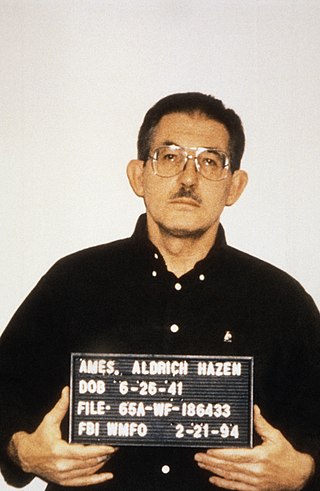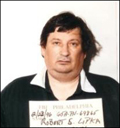Related Research Articles
The Venona project was a United States counterintelligence program initiated during World War II by the United States Army's Signal Intelligence Service and later absorbed by the National Security Agency (NSA), that ran from February 1, 1943, until October 1, 1980. It was intended to decrypt messages transmitted by the intelligence agencies of the Soviet Union. Initiated when the Soviet Union was an ally of the US, the program continued during the Cold War, when the Soviet Union was considered an enemy.

Robert Philip Hanssen is an American former Federal Bureau of Investigation (FBI) double agent who spied for Soviet and Russian intelligence services against the United States from 1979 to 2001. His espionage was described by the U.S. Department of Justice as "possibly the worst intelligence disaster in U.S. history." Hanssen is currently serving 15 consecutive life sentences without parole at ADX Florence, a federal supermax prison near Florence, Colorado.

Aldrich Hazen "Rick" Ames is a former Central Intelligence Agency (CIA) officer turned KGB double agent, who was convicted of espionage in 1994. He is serving a life sentence, without the possibility of parole, in the Federal Correctional Institution in Terre Haute, Indiana. Ames was a 31-year CIA counterintelligence officer who committed espionage against the U.S. by spying for the Soviet Union and Russia. Ames was known to have compromised more highly classified CIA assets than any other officer until Robert Hanssen, who was arrested seven years later in 2001.
Earl Edwin Pitts is a former FBI special agent who was convicted of espionage for selling information to Soviet and Russian intelligence services.

The Espionage Act of 1917 is a United States federal law enacted on June 15, 1917, shortly after the United States entered World War I. It has been amended numerous times over the years. It was originally found in Title 50 of the U.S. Code but is now found under Title 18. Specifically, it is 18 U.S.C. ch. 37

Ronald William Pelton was a National Security Agency (NSA) intelligence analyst who was convicted in 1986 of spying for and selling secrets to the Soviet Union. One such top secret operation he compromised was Operation Ivy Bells.
Plato Cacheris was an American lawyer. He was known as one of Washington's premier defense lawyers, particularly prominent in political scandals.
As early as the 1920s, the Soviet Union, through its GRU, OGPU, NKVD, and KGB intelligence agencies, used Russian and foreign-born nationals, as well as Communists of American origin, to perform espionage activities in the United States, forming various spy rings. Particularly during the 1940s, some of these espionage networks had contact with various U.S. government agencies. These Soviet espionage networks illegally transmitted confidential information to Moscow, such as information on the development of the atomic bomb. Soviet spies also participated in propaganda and disinformation operations, known as active measures, and attempted to sabotage diplomatic relationships between the U.S. and its allies.

Clyde Lee Conrad was a U.S. Army non-commissioned officer who, from 1974 until his arrest on August 23, 1988, sold top secret classified information to the People's Republic of Hungary, including top secret NATO war plans. He was convicted of espionage and high treason in a German court in 1990, and was sentenced to life imprisonment. Graduated from Sebring Mckinley High School in Sebring Ohio. Was a member of and a letterman in both track and rifle. Known as being quiet and a good student.

Jack Edward Dunlap was a United States Army sergeant stationed at the National Security Agency who later became a spy for the Soviet Union in the early 1960s.
Steven John Lalas is an American of Greek descent and former State Department communications officer. Charged with espionage-related offenses in connection with passing sensitive military and diplomatic information to Greece, he was arrested in USA through an FBI sting operation.
This page is a timeline of published security lapses in the United States government. These lapses are frequently referenced in congressional and non-governmental oversight. This article does not attempt to capture security vulnerabilities.
James W. Hall III is a former United States Army warrant officer and signals intelligence analyst in Germany who sold eavesdropping and code secrets to East Germany and the Soviet Union from 1983 to 1988.

Robert Stephen Lipka was a former army clerk at the National Security Agency (NSA) who, in 1997, pleaded guilty to conspiracy to commit espionage and was sentenced to 18 years in prison. He was arrested more than 30 years after his betrayal, as there is no statute of limitations for espionage.

John Anthony Walker Jr. was a United States Navy chief warrant officer and communications specialist convicted of spying for the Soviet Union from 1967 to 1985 and sentenced to life in prison.
Operation Shocker was a 23-year counterintelligence operation run by the US Federal Bureau of Investigation against the Soviet Union. The operation involved the fake defection in place of a US Army sergeant based in Washington, D.C. who, in return for hundreds of thousands of dollars over two decades, provided information to Soviet intelligence (GRU) as agreed by the Joint Chiefs of Staff. This included over 4,000 documents on a new nerve gas the US believed unweaponizable, with the US intending to waste Soviet resources.
Hüseyin Yıldırım is a Turkish-American auto mechanic who was sentenced to life imprisonment in the United States for his courier role in the espionage activities of U.S. serviceman James Hall III during the Cold War era. Yıldırım was later pardoned and extradited to his homeland, where he was sentenced to 17 years in prison but served only one day.
Eastman Kodak v Harold Worden is a case of industrial espionage involving the sale of information by Harold Worden, a former Kodak manager, to Kodak's competitors in 1995. Worden was caught selling details on the 401 process, a process designed to increase the speed and quality of film during development, during a sting operation conducted by Kodak after two of their competitors, Konica and Agfa-Gevaert, told Kodak that he had approached them selling trade secrets. After the sting operation, Worden was sentenced to 15 months in prison and a fine of $30,000 for interstate transportation of stolen property.
References
- ↑ David Sheldon Boone, Page 83, Volume 4, Chapter 2, A Counterintelligence Reader, by National Counterintelligence Center (Author), Frank J Rafalko (Editor), ISBN 9781780395357
- ↑ Thomas, Pierre (14 October 1998). "Ex-Army Cryptologist Accused Of Spying; FBI Says He Sold Secrets to Soviets" . The Washington Post . Retrieved 2014-12-17.
- ↑ Kilian, Michael (14 October 1998). "Ex-soldier Accused Of Spying For Soviets Caught In FBI Sting". Chicago Tribune . Retrieved 2014-12-17.
- ↑ Riesen, James (14 October 1998). "Spy Agencies' Ex-Analyst Charged With Selling Secrets to Soviets" . The New York Times . Retrieved 2014-12-17.
- ↑ "Crime & Justice" . The Washington Post. 6 November 1998. p. B7. Retrieved 2014-12-17.
- ↑ Davis, Patricia (27 February 1999). "Ex-NSA Worker Gets 24 Years for Spying" . The Washington Post. Retrieved 2014-12-16.
- ↑ "Inmate Locator." Federal Bureau of Prisons. Retrieved on June 16, 2015.
- Some of the text in this article is derived from the public-domain United States Department of Defense document Recent Espionage Cases